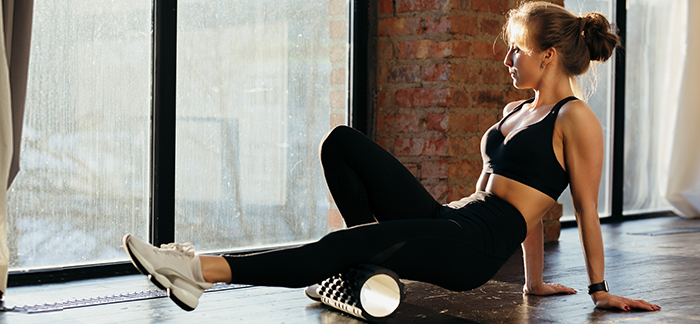
Many people new to exercise purchase a foam roller – then never using it, either for fear of the discomfort or because they actually have no idea how to ‘roll’. The good news is it’s pretty simple to get the hang of it and this incredible invention has the same relief benefits as going to the chiropractor, for half the price.
Firstly, how do you actually ‘roll’?
While you’ve probably been stretching since you can remember, foam rolling is new to many people. A few simple techniques will help make sure you’re rolling correctly and for maximum benefit.
Step 1: Relax. The worst thing you can do as you start to roll a tender area (and we all know there are more than a few) can cause you to become rigid and to stop breathing. Reminding yourself to inhale and exhale deeply will help your muscles to stay loose and you to remain in control of the discomfort.
Step 2: Engage your core. If your core isn’t engaged, your hips and other joints will sag which will in turn throw your alignment out. The art of foam rolling is to keep your body strong and as stiff as possible.
Step 3: Pay attention to pain. Yes, foam rolling isn’t comfortable, but it’s not accompanied by excruciating pain. Remember to roll the muscles not the joins or bones. ;
Step 4: Roll long & slow. Spend at least one or two minutes focusing on the targeted area, rolling fully up and down the entire length of the muscle a few times.
Spend at least one or two minutes focusing on the targeted area, rolling fully up and down the entire length of the muscle a few times.
Let’s begin:
- Pinpoint the sore or tight area of your muscle.
- Control your body as you slowly lower the targeted area, so it’s centered above the roller.
- Lower your body onto the foam roller until you reach a point of discomfort (but not pain) and hold it there.
- Hold for 20–30 seconds. The pressure alone provides benefits, but you can also roll slowly back and forth to further stimulate the area.
- As you're foam rolling, make sure the muscle you're targeting is extended and in a stretch. Keeping that core tight!
Remember: Your pace while foam rolling matters less than making sure you're rolling through the entire muscle.
Some muscle groups to target:

Quads (front of thighs): Lie on your stomach with the foam roller under your thighs. Using your forearms to prop yourself up, roll back and forth on the front of your thighs (also known as your quads), spending extra time on any knots (hold over that position till you feel a release).

Calves & hamstrings (back of thighs): Sit in a seated position with the roller under your calves. Cross your legs so that most of your weight is on one leg. Roll from your ankles to your knees, focusing on any sore spots. Switch sides. To roll out your hamstrings, roll from your knees to your glutes (a.k.a. your butt)

Glutes: Sit on one side, find a sensitive spot and put as much weight as you can on the roller. Switch to the other side and repeat.

Front of shins: Get on your hands and knees with the foam roller under the front of your shins. Roll back and forth on the roller, keeping as much weight as possible on the roller.

Adductor (inside of thighs): Lie mostly flat and place the roll under your thigh. Roll back and forth until you find a sore spot and hold.

IT band (outside of thighs): If you are a runner, this is most likely the most important muscle to roll. If done properly, it can ensure you stay away from injuries such as ITB. Lie on your side with the foam roller under your outer thigh. Roll between the knee and the hip flexor, pausing on any sore spots.

Upper back: Lie on your back with your knees bent and the foam roller under your upper back. Raise your hips off the ground and roll from your upper to mid back, pausing when needed.

Lats: Lie on your side with the foam roller under your armpit. Move forward and back to roll out the lats. If you’ve been doing your push-ups lately, this one may hurt!
As you’re using your foam roller, experiment with slight adjustments to your body position in order to find the most effective technique. Foam rolling can be an effective tool to add to your warm-up or cooldown, before, and after exercise. Working through the discomfort and understanding exactly how your foam roller can be your friend not your foe can help you increase your range of motion and decrease recovery time after a hard workout.
Date Published: 13 March 2023